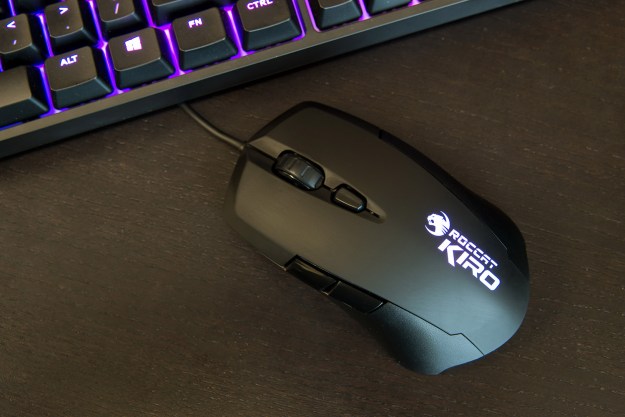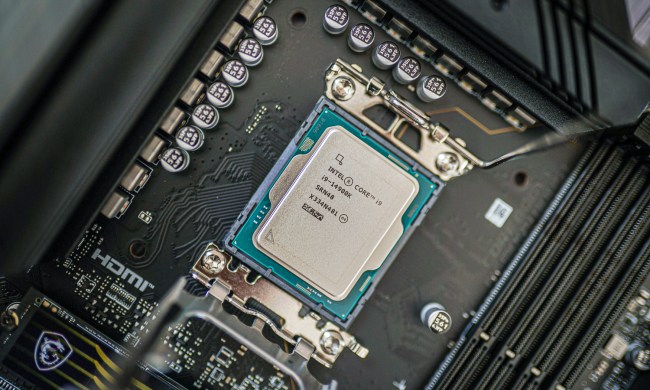
- Unique modular body panels for left- and right-handed use
- Good mix of materials creates a nice grip
- Big comfy thumb buttons for shooter fans
- Heavy body will be a plus to some
- Low price for its elaborate design
- Mediocre laser sensor
- No braided cord
- Conservative all-black design
[specifications product_id=”901236″ align=”right”]
The selection of computer mice, and particularly gaming computer mice, is staggering. But if you’re left-handed, or for some reason you need a mouse that can be used in either hand, your options are limited. There’s just a few ambidextrous gaming mice, and among those, fewer still that are as comfortable for southpaws as for everyone else. Roccat thinks it has a solution to the problem with its Kiro, a uniquely designed modular mouse.
The Kiro is built in the standard “shooter” style, with two large thumb buttons on either side of the long body. But the mouse has a trick up its sleeve, very much like a convertible car — the sides are removable and interchangeable. Both the left side or the right side, and the buttons attached to it, can be removed and replaced with a blank body panel with no buttons. It’s a unique approach, and one that is very much to the benefit of the user.
The Camry of gaming mice
The Kiro is an understated mouse. It’s functional, efficient, and conservative, but not likely to turn heads. Aside from the LED Roccat logo on the palm, there’s nothing that interrupts the staid black plastic body.
The Kiro uses standard left and right buttons, a clickable scroll wheel, two thumb buttons, and a DPI switch button “south” of the scroll wheel, for a total of eight buttons, all programmable via Roccat’s desktop software. Depending upon the user configuration it can have six buttons, or even four, if you find the extras only get in the way.
The sensor is a laser module, with a rather low 2,000 native DPI that can be “overcharged” to 4,000. Some may view this as the Kiro’s weak point, as it’s well below competitors, many of which can offer up to 8,200 DPI. But high sensor resolution isn’t always necessary, as it can boost sensitivity beyond what an average gamer can handle. I found the sensitivity more adequate for my gaming. Still, the fact it’s not an option is a negative. Mice with better sensors can always have their sensitivity turned down, resulting in a greater range of customization.
This mouse is an elegant solution for ambidextrous use.
The body combines three different textures — soft-touch plastic on the palm area and primary buttons, rough matte plastic on the sides, and glossy plastic on the thumb buttons. The body is mid-sized, longer than a regular mouse but a bit shorter than many gaming models, with a high arch that’s best used with a standard palm grip. The wheel is large and uses soft-touch plastic with widely-spaced grooves, good if you’re scrolling through weapons, but not if you’re browsing a document.
The cord is 1.8 meters (about five and a half feet). It uses a standard plastic coating instead of the more popular and more durable braided cord that’s become so popular as of late.
Southpaws welcome
The Kiro’s unique trick is its removable panels. Its underside hides slots that allow the user to remove the left and right body panel with simple and easy pressure. Once removed, you can slide in a “blank” body panel. Left-handed users should put the blank panel on the left side, and right-handed users should put the blank panel on the right – that way the dominant hand’s thumb has easy access to the thumb buttons, and there are no buttons on the opposite side.
This design allows the Kiro to overcome the biggest problem with ambidextrous mice — the extraneous buttons on the non-dominant side of the mouse. While some gamers are dexterous enough to use buttons on the opposite side with their ring or pinky fingers, most (including yours truly) find them cumbersome. I usually disable the opposing thumb buttons in software, but with the Kiro, that’s not necessary.
It’s functional, efficient, and conservative – which means it looks rather dull.
The removable panels slide into place snuggly, and once adjusted, the mouse doesn’t feel as though it’s modular at all. It’s an excellent design that feels more complete than competitors with similar elements, like Razer’s Ouroboros. The Kiro is symmetrical and the dimensions and ergonomics aren’t changed when switching panels, aside from the buttons, or lack thereof.
Roccat says that it plans to supply files that will let users 3D print extra panels for the left and right side. They’re not available now (and I don’t have a printer to test them with), but it’s an interesting idea.
Using the Kiro
I had no trouble acclimating myself to using the Kiro in my favorite shooters like Titanfall and Primal Carnage. The long, wide thumb buttons are comfy, much more so than some of the thinner and more angular designs I’ve used. The mouse is heavier than many wired models, presumably as a by-product of its modular build. Roccat doesn’t provide a weight in its technical specifications, but it’s nearly as heavy as my Logitech MX Master, which is 145 grams. I like a heavy mouse, even for gaming, but those who prefer a light touch will be off-put.
The combination of rough plastic on the sides and soft-touch on top is effective, though those with a claw grip probably won’t like it. I didn’t encounter any problems with the modular panel implementation. It’s equally comfortable in either hand and in either configuration. The DPI switch is a single button which has to cycle through the settings, rather than a rocker, but that’s a common and rather minor problem among gaming mice.
Software
All of Roccat’s gaming hardware uses the same “alien control console” color scheme and layout from gaming hardware in general. I’ve grown to loathe the overstated colors and inefficient layouts, but Roccat’s is no better or worse than its competitors. I don’t appreciate the large initial download, or the required plugins in order to access the Kiro’s options. Luckily it’s only necessary if you want to program macro key assignments or change the single LED on the mouse, so most users won’t even need to install it.
The Swarm software allows users to assign up to five default states for the mouse’s DPI switcher, anywhere from 250 all the way up to 4,000, in steps of 50. The lighting can be customized among a variety of RGB colors, and the LED can be set to be steady, blinking, or breathing, with a color cycle option that can be set to custom speeds. The button assignment tab allows for more or less any assignment to any slot (including swap options for the body panels), plus macros and profiles that can be bound to specific games or programs.
Conclusion
Roccat has set a 50 Euro MSRP the Kiro, which would place it at about $55 bucks if exchange rates were followed. But on Amazon, Newegg, and other retailers, the “street price” is closer to $40. At the original price the low-power sensor and non-braided cord would be a problem, but for forty bones, the Kiro is a good deal. It’s more comfortable to my hand than competitors like the Razer Diamondback and the Cougar 450M, and it’s considerably cheaper, to say nothing of the unique modular design. Gamers who are looking for a similar body shape with a better sensor (sadly omitting the modular body) should investigate the Mionix Avior 7000.
The Kiro’s unique approach to ambidextrous ergonomics makes it notable, as it’s rare to see such an experimental feature succeed so well on a company’s first attempt. That, combined with sensible if somewhat dull choices elsewhere, and a low street price, make it an ideal choice for the left-handed PC gamer on a budget, or even a right-handed player who wants a well-rounded, inexpensive mouse. The only potential deal breaker is the low-power sensor, which may hold back extremely skilled players who can use additional sensitivity.








